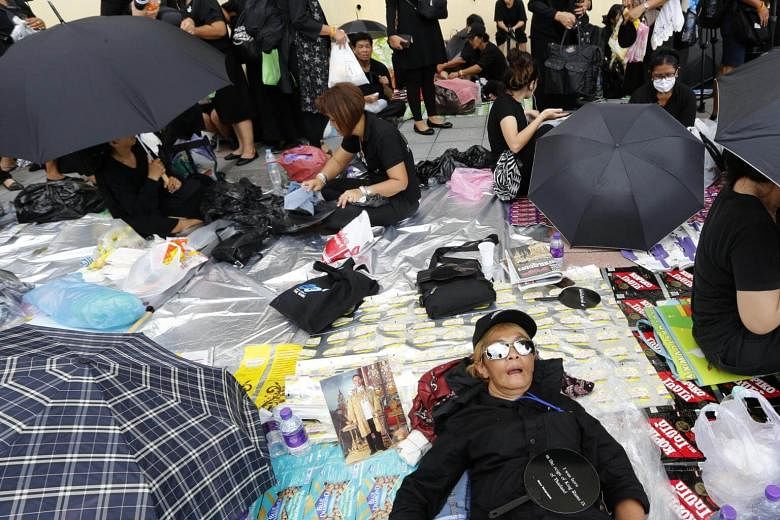BANGKOK - When Thailand's King Bhumibol Adulyadej died in October last year, Ms Supitta Tolumthanapisarn was among the grieving masses who lined the streets of Bangkok as the authorities transferred his body from Siriraj Hospital to the Grand Palace.
She visited the Grand Palace seven times over the past year, as his body lay in state during the official mourning period.
On Tuesday (Oct 24), two days before the revered monarch's body is due to be cremated ,she joined crowds of devotees camping out on the sidewalks near security checkpoints for the royal crematorium grounds.
The kingdom is sending off the late monarch in a lavish ceremony, involving a morning procession that will transport the royal urn to a purpose-built crematorium in the heart of Bangkok. Even though the crematorium area is accessible to procession-viewers only from 5am Wednesday (6am Singapore time), mourners camped in front of the checkpoints on Monday or earlier to secure a viewing spot.
The early birds braved rain and sun, some armed with nothing more than raincoats and umbrellas as they slept on thin mats on the sidewalk.
Ms Supitta, a 59-year-old food vendor, arrived near the site at 1pm on Tuesday with two neighbours, only to realise much of the footpath ringing the site had been occupied. They ended up on a sidewalk in front of a shuttered shop, where they sat with their provisions of wet tissue, deodorant, ponchos and some food.
"This place is so narrow that it's hard to lie down, but we will stay here," she told The Straits Times. "I am ready to face any difficulty just to see him on the last day."
King Bhumibol is often seen as a unifying figure in the politically riven country, who lent his clout to numerous projects to improve rural livelihoods.
To honour him, the military government has set aside 3 billion baht (S$123 million) for a tightly choreographed five-day send-off starting on Wednesday at the elaborate crematorium with spire-roofed pavilions and sculptures of mythical creatures, all created from scratch over the past year. On Thursday, the day he is cremated, more than 2,000 artistes will put on traditional Thai performances as well as play the songs he composed.
In the lead-up to the event, Thai authorities had issued strict rules for the media and the public. Those watching the procession, for example, were urged not to bring colourful umbrellas, eyeglasses and even cellphone covers. Selfie sticks are banned. The media were not allowed to do their own live Facebook broadcasts.
Some mourners like Ms Siripen Srinikon had booked hotel rooms nearby, but gave up the rooms to sleep on the pavement to ensure a viewing spot for the procession. On Tuesday afternoon, she sat on the pavement with her suitcase, which contained a traditional long-sleeved black dress that she intended to wear for the event.
"This is the first time I am doing this, sleeping on the pavement surrounded by the crowd and cars," the 47-year-old businesswoman told The Straits Times.
"But this is the only chance I can get close to him… This is like when you lose your parents and want to be close to them for the last time."


